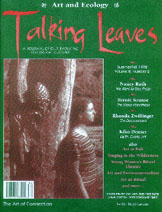Ecological art springs from a long tradition--one that, in the United States at least, dates back to the 19th century. Landscape painters from the Hudson River School were among the first to warn of the danger of "the wilderness passing away and the necessity of saving and perpetuating its features," as Thomas Cole, founder of the Hudson River School expressed it. Their panoramic vistas romantically documented the wilderness they sought to preserve and occasionally contained foreboding images of industrial encroachment as well. In Andrew Melrose's "Westward the Star of the Empire Takes its Way," the blinding glare of a train's searchlight shines out against the darkening evening sky with prophetic implications. However obscured by the self-referential painterly traditions which culminated in Abstract Expressionism and Post Expressionism, both impulses of the Hudson River School--the celebration of nature and the depiction of technology's encroachment--have lived on through Ryder, Homer, and Hopper, to name just a few, well into our times.
Katherine Kormendi
Ecological Art
1998 Fall | Katherine Kormendi
One of the most interesting developments on the international art scene today is the growth of so-called Ecological Art--art created in direct response to the environmental crisis. Everywhere, artists are voicing their concern, creating works to dramatize this concern, and working directly on the earth itself--sculpting it, transmuting it-- to repair the damage done.
